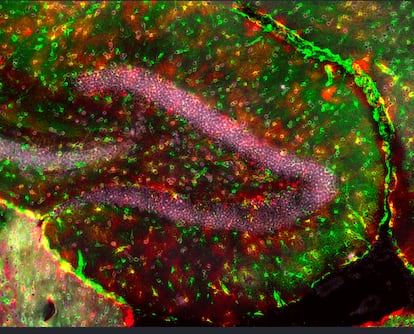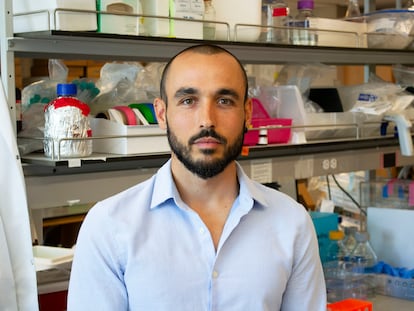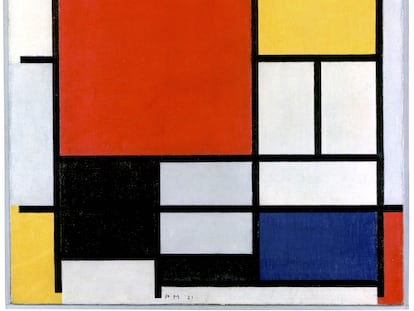New type of cell discovered in the human brain
These ‘glutamatergic astrocytes’ could play a role in understanding disorders such as Alzheimer’s, according to the scientists who have discovered them

In 1888, a 36-year-old man named Santiago Ramón y Cajal set up a laboratory in his Barcelona residence. He began to study slices of human brains under his microscope. He was able to obtain the organs from the abundant corpses at the neighboring hospital. While examining the slices in his home, he was able to come across an “inextricable forest” on the other side of the lens. As he entered this jungle, he was eventually able to show how the brain is organized into individual cells, with neurons being the main protagonists of thought.
The Italian neuroscientist Andrea Volterra has been telling the story of Cajal to his students at the University of Lausanne (Switzerland) for years. However, this past Wednesday, it was he who announced the discovery of “a new type of cell” in the human brain.
The thickness of that cerebral jungle is unimaginable. The 1.5-pound gray organ inside a person’s skull is made up of some 86 billion neurons, with trillions of communication points between them. Until Cajal appeared, the scientific community believed that the brain was a diffuse mass of cells physically connected to each other. The Spanish researcher showed that these were independent entities, although they caressed and communicated via what he poetically called “kisses.” Today, they’re known by a more boring term: synapses.
Neurons are surrounded by another family of cells — the glial cells — which act as supports for brain activity. Glia, in Greek, means “glue.” It’s the glue of ideas. One of these cells is the astrocyte, named for its star shape. A single astrocyte can participate in two million “kisses” (synapses) between neurons. In those kisses, neurons send messages that contain chemical substances, especially glutamate — a molecule made up of five carbon atoms, nine hydrogen, one nitrogen and four oxygen: C₅H₉NO₄. This process is essential for human abstract thought.
Volterra’s team has detected a new type of cell that doesn’t belong to the canonical categories of neurons or astrocytes. What has been discovered are “hybrid cells,” according to the Italian. The neuroscientist Liset Menéndez de la Prida — who didn’t participate in this research — believes that this is “a transcendental discovery” that will change the way in which we understand the functioning of the brain and its disorders.
Volterra has given these new types of cells the name “glutamatergic astrocytes.” This subpopulation of astrocytes has part of the molecular machinery of neurons necessary to release glutamate, according to Menéndez de la Prida, from the Cajal Institute in Madrid. “Information between neurons moves fast — it takes just a few milliseconds, or as much as tens of milliseconds if [the synapses] occur between several neurons in a chain (polysynapses). In contrast, astrocytes can take full seconds to transmit information. This subpopulation showed response times below one second, which is [closer to] polysynaptic responses,” Menéndez de la Prida notes. The neuroscientist stresses that it’s a small population of cells and that their true proportion in the brain is unknown, but she stresses that the discovery has been “a groundbreaking result.”

Andrea Volterra believes that his discovery “shakes the foundations of neuroscience” because it questions current knowledge about how the brain works and how neurological disorders develop. His team’s study — published this past Wednesday in the journal Nature — shows that glutamatergic astrocytes are concentrated in the brain regions involved in memory. One of them — the hippocampus — is one of the most unstable areas at the beginning of Alzheimer’s disease. “That’s why we have well-founded suspicions that our cells could be involved,” Volterra explains.
The team has also observed that glutamatergic astrocytes play a role in a circuit that controls movement and is altered by Parkinson’s: the nigrostriatal dopamine pathway. “We haven’t yet studied the distribution of these cells in other brain regions. What we discover will guide our future investigations. For example, if we find a high concentration of these cells in the prefrontal cortex (the area of the brain located behind the forehead), we will immediately study its role in decision-making and its alteration in schizophrenia,” Volterra affirms. “If we find them in the horns of the spinal cord, we can think about amyotrophic lateral sclerosis (ALS).”
Neuroscientist Marta Navarrete — also from the Cajal Institute — applauds the new study, but believes that glutamatergic astrocytes are more of a subtype of astrocytes, rather than a new type of cell. “We’ve known of astrocytes since the time of Cajal. It had always been thought that these cells feed neurons and act as their structural support, but now, it’s being observed that they’re much more important. They intervene in the memory and learning process, in fear, in all the superior emotions that a human being can have,” Navarrete points out. Volterra’s work suggests the existence of nine classes of astrocytes, which would add up to more than a hundred types of neurons.
The researcher who first observed that astrocytes are involved in superior information processes was another Spaniard: Alfonso Araque, who works at the University of Minnesota. In 1999, Araque abandoned the topic of the “kiss” between two neurons and put forward the concept of a “tripartite synapse,” in which astrocytes also play a fundamental role.
Navarrete — a disciple of Araque — emphasizes that there’s still resistance to this approach. “The idea that there are types of astrocytes specialized in certain functions isn’t accepted in the scientific community. It’s not fully accepted that there may be more cells [besides neurons] that are highly involved in information-processing,” she laments. The latest discovery by Andrea Volterra’s team adds even more complexity to the inconceivable human brain.
Sign up for our weekly newsletter to get more English-language news coverage from EL PAÍS USA Edition
Tu suscripción se está usando en otro dispositivo
¿Quieres añadir otro usuario a tu suscripción?
Si continúas leyendo en este dispositivo, no se podrá leer en el otro.
FlechaTu suscripción se está usando en otro dispositivo y solo puedes acceder a EL PAÍS desde un dispositivo a la vez.
Si quieres compartir tu cuenta, cambia tu suscripción a la modalidad Premium, así podrás añadir otro usuario. Cada uno accederá con su propia cuenta de email, lo que os permitirá personalizar vuestra experiencia en EL PAÍS.
¿Tienes una suscripción de empresa? Accede aquí para contratar más cuentas.
En el caso de no saber quién está usando tu cuenta, te recomendamos cambiar tu contraseña aquí.
Si decides continuar compartiendo tu cuenta, este mensaje se mostrará en tu dispositivo y en el de la otra persona que está usando tu cuenta de forma indefinida, afectando a tu experiencia de lectura. Puedes consultar aquí los términos y condiciones de la suscripción digital.
More information
Archived In
Últimas noticias
ICE raids trigger school absenteeism and traumatize children: ‘They have been forced to leave their childhood behind’
The guardians of the meteorites of the Argentine Chaco
Helen Levitt, the photographer who captured the theater of the everyday
The life of a delivery driver in China: ‘Many people don’t know how an order can arrive at their home in just one day’
Most viewed
- Christian Louboutin: ‘Young people don’t want to be like their parents. And if their parents wear sneakers, they’re going to look for something else’
- US sanctions against jailed cartel leader ‘El Marro’ highlight Mexico’s lack of control over its prisons
- The low-cost creative revolution: How technology is making art accessible to everyone
- Liset Menéndez de la Prida, neuroscientist: ‘It’s not normal to constantly seek pleasure; it’s important to be bored, to be calm’
- Cartels in Mexico take a leap forward with narco-drones: ‘It is criminal groups that are leading the innovation race’











































